#and blair writes for the local newspaper
Text
derena art thieves/ detective nate AU -> endgame: derenate
#i want to read this SO badly but i don't want to write it#i mean ultimately i WILL write it#but i want it to already exist#30k of shenanigans#discussions of how museums further inequalities in society#discussion of colonialism#ok but i can't write a fic like this without having blair somewhere#like thematically this needs blair#blairnessa can be a journalist duo probably#vanessa's making a documentary on art forgery#and blair writes for the local newspaper#IM REALLY GOING TO HAVE TO WRITE THIS huh#prompt
4 notes
·
View notes
Note
Since It's Ramadhan Mubarak, I was wondering what would ROs act around MC who's fasting?
They’re all supportive and understanding!
August hosts iftar a few times every week and does their best to include the mc’s favourite foods. They're mindful of Muslim diet restrictions (ie: always excluding pork).
Blair offers all employees who observe Ramadan flexible work hours. Employees can choose to take paid time off, come in later in the day to rest in the mornings and/or adjust work duties accordingly. Blair will convert a quiet, secluded space in the station into an area where employees can pray. If close with the mc (platonic or romantic), Blair will offer their office to the mc to nap if they’re feeling tired during their lunchbreak.
Wren would feel compelled to avoid eating around the mc, even if this is a bit misguided. They would feel guilty eating near the mc while they fast.
Neve would fall down a rabbit hole of research about Muslim customs/traditions and Ramadan. They would probably write an article on their blog/the local newspaper educating people about Ramadan, dispelling stereotypes and sharing ways people can support those celebrating.
Ramadan Kareem!
33 notes
·
View notes
Photo

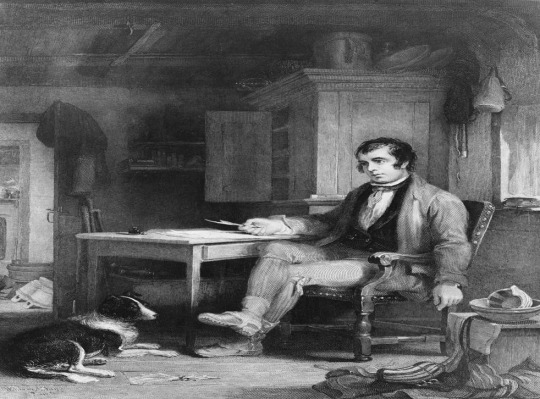
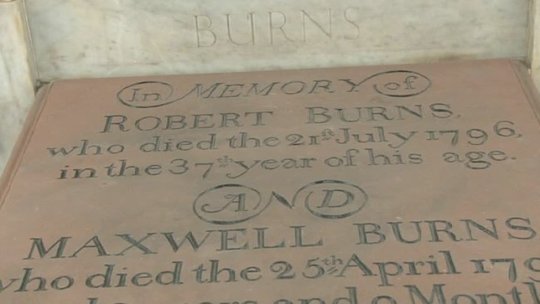
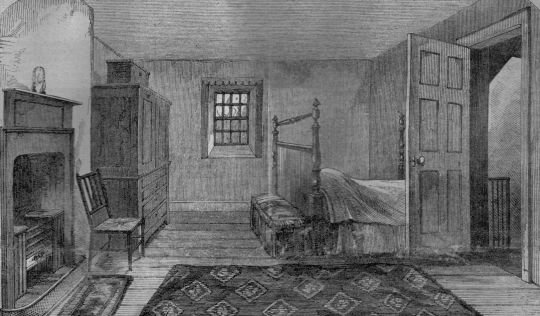

On 21st July 1796 Robert Burns died in Dumfries.
Rather than write up an account from several sources and my own knowledge as I normally do I will leave it to the poet and neighbour of the Ploughman Poet, Alan Cunninham, to describe the fateful day……
“It was soon spread through Dumfries that Burns had returned from the *Brow much worse than when he went away, and it was added that he was dying. The anxiety of the people, high and low, was very great. I was present and saw it. Wherever two or three were together their talk was of Burns, and of him alone. They spoke of his history, of his person, and of his works - of his witty sayings and sarcastic replies, and of his too early fate with much enthusiasm, and sometimes with deep feeling. All that he had done, and all that he had hoped he would accomplish, were talked of: half-a-dozen of them stopped Dr. Maxwell in the street, and said, "How is Burns sir?” He shook his head, saying, “he cannot be worse, ” and passed on to be subjected to similar inquiries farther up the way. I heard one of a group inquire, with much simplicity, “Who do you think will be our poet now?”
Though Burns now knew he was dying, his good humour was unruffled, and his wit never forsook him. When he looked up and saw Dr. Maxwell at his bed-side, - “Alas!” he said, “what has brought you here? I am but a poor crow and not worth plucking.” He pointed to his pistols, those already mentioned the gift of their maker, Blair of Birmingham, and desired that Maxwell would accept of them, saying they could not be in worthier keeping, and he should have no more need of them. This relieved his proud heart from a sense of obligation. Soon afterwards he saw Gibson, one of his brother-volunteers by the bed-side with tears in his eyes. He smiled and said, - “John, don’t let the awkward squad fire over me!”
His household presented a melancholy spectacle: the Poet dying; his wife in hourly expectation of being confined: four helpless children wandering from room to room, gazing on their miserable parents and but too little of food or cordial kind to pacify the whole or soothe the sick. To Jessie Lewars, all who are charmed with the poet’s works are much indebted: she acted with the prudence of a sister and the tenderness of a daughter, and kept desolation away, though she could not keep disease. - “A tremor,” says Maxwell, “pervaded his frame; his tongue, though often refreshed, became parched; and his mind, when not roused by conversation, sunk into delirium. On the second and third day after his return from the Brow, the fever increased and his strength diminished. On the fourth day, when his attendant, James Maclure held a cordial to his lips, he swallowed it eagerly - rose almost wholly up - spread out his hands - sprang forward nigh the whole length of the bed - fell on his face and expired. He was thirty seven years and seven months old, and of a form and strength which promised long life; but the great and inspired are often cut down in youth while "Villains ripen gray with time”.
I can’t really add to what Cunningham has written, what I will add is the remarkable story about the night almost 40 years after his death the poet’s skull was taken on a wee walk by a group of Dumfries locals with a strange interest.
The men, led by newspaper editor John McDiarmid, were keen advocates of phrenology - a now discredited pseudo-science that believed you could read deep truths about someone's personality from plotting the bumps on their head.
McDiarmid and others were keen to study the skull of the ploughman poet - a man who was thought of as a natural genius and whose personality was well-known throughout the world.
The phrenologists were interested in Burns because he was such an important character in the public imagination and therefore they wanted to see if the bumps on his skull would match up to his public persona.
However, the Bard's widow Jean Armour was not thought to be keen to allow the phrenologists to disturb her husband's resting place because his remains had already been moved once before.
When Burns died in Dumfries he was not buried in the imposing mausoleum that currently stands in the town's St Michael's kirkyard. The bright, white, rock star tomb, with its pillars and domes and its marble figure of Burns at the plough, was erected 19 years after his death, following a long fundraising effort. His widow was disgusted by the gruesome exhumation of the poet's body, and the remains of two of his sons, to the relocate them to the new monument.
Dumfries Courier editor McDiarmid wrote an account of removing Burns from his original resting place.
He told how when the workmen tried to lift the original wooden coffin "the head separated from the trunk, and the whole body, with the exception of the bones, crumbled into dust".
The newspaper editor may have been accurately describing the scene but he was not there at the time, he arrived in town two years after the event and must have cursed his luck at missing out on getting his hands on Burns' skull for a phrenological study.
It was not until Jean Armour died in 1834 that another opportunity arose to get a plaster of Paris cast of the skull. McDiarmid realised the crypt of the mausoleum was going to be opened and he appears to have obtained permission from Jean's brother to take a cast of the skull. The group carrying out the plan comprised of six men plus their assistants, and by the end of the night the Provost, the Dean of Guild and rector of Dumfries academy as well.
They don't want to be seen and they didn't want a mob to assemble and say 'here they are violating the poet's grave, we are going to stop them. They make their first attempt at 7pm but there are too many people about. At 10pm in come our boys again over the walls, sneak up to the mausoleum with the keys, they go down into the vault with a ladder and a muffled lantern so people didn't see the light.
According to Burns' experts who reconstructed the process, McDiarmid had thought he would be able to take a plaster cast of the skull in the vault but he realised he couldn't. So he popped it into a linen bag and walked it up the high street to Queensberry Street where the plasterer James Fraser worked. They made a mould and from that they took a cast of the skull.
There are several persons involved, one of which is the surgeon Archibald Blacklock and according to the published accounts he, very scientifically, handles this skull.
He also apparently tried his hat on it out of awe, because the skull is so large he wants to know if his hat can fit on it or not. The workmen around him then all apparently try their hats on the skull as well. The freshly-cast skull was rushed to Edinburgh, to George Combe, the master of phrenology, who prepared a report on Burns' personality.
Phrenologists believed the brain was made up of 27 individual "organs" that determined personality and these could be measured by studying the shape of the skull. Combe's report rated Burns for a number of character traits based on the size of the "organs".
One of Burns' organs that was very large was his organ of “philoprogenitiveness,” his ability to produce and care for children! Along with a high score for benevolence, the phrenologists said this explained his love for weak and helpless creatures displayed in poems such as To a Mouse and On Seeing a Wounded Hare. A lot of it was just talking about the poetry and the life and trying to make sense of this scientific analysis in relation to Burns' well-known public character and his written work.
This was a "risky" strategy, because Burns was so well-known that if their findings had been at odds with his public persona it would have made phrenology look like a fraud. So they worked very hard to make sense of these materials. Instead of the scientific philosophy of trying to prove your hypothesis wrong, the phrenologists wanted to confirm their prior beliefs.
The anatomical museum of the University of Edinburgh has a cast of Burns' skull which is likely to be one of the original copies made that night in 1834, there is also a copy in The Burns Museum at Alloway.
Pics include a drawing of the poets “death room” and the skull in the museum.
31 notes
·
View notes
Text
November 27th marks a dark day in the history of the Battlefords. It is the anniversary of the executions which took place at Battleford in 1885, which were also the largest mass execution in Canadian history.
Six nêhiyawak (Plains Cree) and two Assiniboine men were hung at Battleford and their bodies dumped into an unmarked grave that remained undiscovered until the 1970s when erosion on the riverbank exposed some of the remains.
The men were named:
Kah - Paypamahchukways (Wandering Spirit)
Pah Pah-Me-Kee-Sick (Walking the Sky)
Manchoose (Bad Arrow)
Kit-Ahwah-Ke-Ni (Miserable Man)
Nahpase (Iron Body)
A-Pis-Chas-Koos (Little Bear)
Itka (Crooked Leg)
Waywahnitch (Man Without Blood)
Some facts about the hangings at Battleford:
1. Judge Rouleau, the man who sentenced the eight men to die at Battleford, had his house in Battleford burned during the Resistance: The local newspaper at the time reported that Judge Rouleau: "is reported to have threatened that every Indian and Half-breed and rebel brought before him after the insurrection was suppressed, would be sent to the gallows if possible. In view of all the circumstances, and particularly as Judge Rouleau was a heavy loser pecuniarily by the Indian outbreak at Battleford, it is contended that he should not have been allowed to preside at the trial of the prisoners. A memorial has been received by the Department of Justice asking that the matter be investigated."
2. Although the men spoke Cree - not English, none were provided with a translator at their trials.
3. Almost all of the historical writings about the hangings were written from the perspective of settlers. "Blood Red the Sun" and other narrative accounts paint the men as criminals. Barry Degenstein, local author of "In Pursuit of Riel," as one relatively recent example, has continued to assert the men were "cold blooded murderers of innocent civilians." (See: https://www.newsoptimist.ca/opinion/letters/grave-not-that-of-heroes-and-warriors-1.1568415) It is important to remember that the North West Mounted Police (now Royal Canadian Mounted Police) played a major role in colonizing the region around the Battlefords and committed serious violent acts against Indigenous people here. The history of the Battle of Cut Knife Hill and other major events are primarily told in history books and other accounts from the perspective of the colonizers and settlers. (See also: Views from Fort Battleford: Constructed Visions of an Anglo-Canadian West - https://archive.org/details/ViewsFromFtBattleford)
4. Hayter Reed, the Assistant Indian Commissioner in 1885, wanted a public execution. He asked the Lieutenant Governor to send any Indians who were sentenced to death during the second series of Regina trials so they could be executed with those sentenced to die in Battleford. He insisted that "the punishment be public as I am desirous of having the Indians witness it - no sound thrashing having been given them, I think a sight of this sort will cause them to meditate for many a day and besides have ocular demonstration of the fact." This was echoed in the local newspaper. The Saskatchewan Herald’s P.G. Laurie understood the importance to the government of making the hangings a public spectacle. “We are not in favor of public executions as a rule,” wrote Laurie, “but we believe that in this instance it would have a wholesome influence on the Indians at large to have the extreme penalty of the law so carried out on those whom the court may find guilty.” Laurie viewed the hangings as a type of deterrence to further violence, arguing that the calm administration of punishment would impress the Native population more than further battlefield bloodshed. Laurie also agreed with the government that the executions should happen at the place of the capital trials, in Battleford. Laurie argued, “[I]f the Department of Justice will.. .permit the executions to be public, the sight will have such an effect upon the native beholders as will make them think twice before they again take up arms.” (See "A Lesson They Would Not Soon Forget" Chapter 3: https://drive.google.com/file/d/1yvqkd4LfbfO4YC5mWcQS0QfCPVEWNo_k)
5. The biography of Senator John Tootoosis notes at page 77 that among the witnesses at the hangings were "the Indian children from the Battleford Industrial School who had also been brought to see the eight men die. It was a part of their education that none of them would soon forget!"
6. One week prior to the hangings, Prime Minister John A. MacDonald wrote in a confidential letter to the Indian Commissioner: "The executions... ought to convince the Red Man that the White Man governs."
7. Little Bear continued to assert that he was innocent until his death.
8. "Loyal Til Death" (a thoughtful account of the true history of this period by Blair Stonechild and Bill Waiser - https://www.amazon.ca/Loyal-Till-Death-North-West-Rebellion/dp/1897252730/) discusses the terrorizing effect the hangings had on Indigenous people in the region: "As for the Indians assembled in front of the gallows, they watched in quiet horror as the men dropped to their doom and then silently moved off once the bodies had been placed in the coffins. Nothing was said or done. They simply returned to their reserves, trying to put behind them the shock of the executions. But to this day, the executions have remained a numbing event, comparable to an old scar on the soul of a people. Elder Paul Chicken of the Sweetgrass reserve recalled how the Indians of the area lived in morbid fear of being picked up and tried before "Hanging Judge Rouleau." Dressyman's grandson, meanwhile, related how his reprieved grandfather and several other men were forced to watch the executions and threatened with a similar fate if there was any more trouble. "My grandfather was there, he saw them hung, he watched it all," he recounted. "They didn't like the hanging... the law overdone it." Don Chastis, a descendent of one of the Cut Knife warriors, said that he often heard the Elders speak of the bravery of the condemned men, how they all sang on the platform in the face of death. He also speculated that the police refused to release the bodies for a traditional burial because the government did not want the men glorified as braves. "So they were forbidden to have anything to do with them. That's why they buried them right there in a mass grave," Chastis said. "It would have defeated the whole purpose of the hanging if they let these people [bodies] go." The Battleford trials and executions accelerated the exodus of Indians to the relative safety of the United States." (At page 226-227 of 'Loyal Til Death.')
9. There are almost no artistic works or photographs that depict the hangings other than the attached illustration from "Loyal Til Death" by Blair Stonechild and Bill Waiser - https://www.amazon.ca/Loyal-Till-Death-North-West-Rebellion/dp/1897252730/
We remember the eight men who were executed at Battleford, and encourage people to consider the perspective of the historical accounts and begin working to decolonize the accounts of this history.
Is it time to consider exonerating or posthumously pardoning the eight warriors executed at Battleford?
(See: https://www.cbc.ca/news/politics/pm-trudeau-exonerate-tsilhqotin-chiefs-1.4593445)
CBC Saskatchewan APTN Federation of Sovereign Indigenous Nations - FSIN Office of the Treaty Commissioner
51 notes
·
View notes
Text
Here’s Part One of a series of articles I wrote a while back:
Goebbels and today’s mass mind control: Part One
How PR opinion-shapers turn the people against their own interests By Carla Binion (”thinkveganworld.tumblr.com”)
Today’s right-wing public relations spin has much in common with the propaganda methods of Hitler’s PR man, Joseph Goebbels. Goebbels admired Edward Bernays, a self-proclaimed founder of the public relations industry. Bernays, a Vienna-born nephew of Sigmund Freud, opened a New York office in 1919. According to John Stauber and Sheldon Rampton, (“Toxic Sludge is Good for You,” Common Courage Press, 1995) Bernays “pioneered the PR industry’s use of psychology and other social sciences to design its public persuasion campaigns.”
Bernays wrote in “Propaganda,” (New York: 1928, pp. 47-48) “If we understand the mechanism and motives of the group mind, it is now possible to control and regiment the masses according to our will without their knowing it.” Bernays referred to this scientific opinion-control as the “engineering of consent."
In his autobiography, Bernays discusses a dinner at his home in 1933 where, "Karl von Weigand, foreign correspondent of the Hearst newspapers, an old hand at interpreting Europe and just returned from Germany, was telling us about Goebbels and his propaganda plans to consolidate Nazi power. Goebbels had shown Weigand his propaganda library, the best Weigand had ever seen.
Goebbels, said Weigand, was using my book ‘Crystallizing Public Opinion’ as a basis for his destructive campaign against the Jews of Germany. This shocked me. Obviously the attack on the Jews of Germany was no emotional outburst of the Nazis, but a deliberate, planned campaign."
Today, corporations spend millions on public relations campaigns to "crystallize public opinion,” often in an effort to convince the public that harmful things are actually good for us. Sometimes the companies start by bending the minds of our elected representatives.
This is the first part of a series. In part one, we’ll focus on the ways in which corporations and their public relations mind-shapers worked to destroy the Clinton health care plan. Today forty-four million Americans, about one in five people, have no health coverage, and many people cannot afford needed pharmaceutical drugs. Most Americans probably wonder why, despite repeatedly broken campaign promises, Congress never does anything to improve the health care system.
As far back as November 8, 1999, a Newsweek article reported that half or more of eligible heart attack patients are at greater risk because they can’t get needed beta blockers. The article stated that two-thirds of people surveyed say they are worried that health care is no longer affordable. Conditions haven’t improved since then.
In 1993, the Clinton administration tried to do something about the high price of prescription drugs, hinting at possible government-imposed price controls. The pharmaceutical industry then turned to the Beckel Cowan PR firm to oppose the administration’s designs on lowering the cost of prescription drugs – although, of course, the Clinton plan would have benefited the public. Stauber and Rampton write that Beckel Cowan “created an astroturf [or, fake grassroots] organization called 'Rx Partners’ and began deploying state and local organizers to, in the words of a company brochure, 'generate and secure high-quality personal letters from influential constituents to 35 targeted members of Congress.’"
At the same time, Beckel Cowan managed a mail and phone campaign "which produced personal letters, telegrams and patch-through calls to the targeted members’ local and Washington, DC, offices.” The PR firm built a network of supporters in 35 congressional districts and states. Pharmaceutical companies weren’t the only corporations to oppose an improved health care system.
The insurance industry went to work to fight against the Clinton health care plan, recruiting PR-man Robert Hoopes. According to Stauber and Rampton, the 300,000 member Independent Insurance Agents of America (IIAA) hired Hoopes as their “grassroots coordinator/political education specialist."
Campaign & Elections magazine reported the IIAA activated "nearly 140,000 insurance agents during the health care debate, becoming what Hoopes describes as a new breed of Washington lobbyists,” wrote Stauber and Rampton. Hoopes said the lobbyists “have behind them an army of independent insurance agents from each state, and members of Congress understand what a lobbyist can do with the touch of a button to mobilize those people for or against them."
In Campaign & Elections magazine ("Killing Health Care Reform,” October/November 1994) Thomas Scarlett writes of the insurance companies PR moves, “Through a combination of skillfully targeted media and grassroots lobbying, these groups were able to change more minds than the president could, despite the White House 'bully pulpit.'
Never before have private interests spent so much money so publicly to defeat an initiative launched by a president.” The Coalition for Health Insurance Choices (CHIC), an insurance company front group, led the attacks on health care reform. According to Consumer Reports, “The HIAA [Health Insurance Association of America] doesn’t just support the coalition; it created it from scratch.” Stauber and Rampton write that PR-man Blair G. Childs masterminded the Coalition.
Describing the fight against health care reform, Childs said in 1993, “The insurance industry was real nervous. Everybody was talking about health care reform. It felt like we were looking down the barrel of a gun.” He added, “We needed cover because we were going to be painted as the bad guy. You get strength in numbers. Start with the natural, strongest allies, sit around a table and build up to give your coalition a positive image."
To battle health care reform, Childs said the coalition brought in "everyone from the homeless Vietnam veterans to some very conservative groups. It was an amazing array, and they were all doing something.” (Blair Childs speaking at “Shaping Public Opinion: If You Don’t Do It Somebody Else Will,” in Chicago, Dec. 9, 1994.)
Childs advised industry health reform opponents on selecting names for their fake grassroots coalitions. He said they should use focus groups and surveys to find “words that resonate very positively.” (Examples included the words “fairness, balance, choice, coalition and alliance.”)
His own coalition sponsored the famous “Harry and Louise” television spots. Those ads used strategic words to convince the public that Clinton’s health care plan was overly complex – a “billion dollar bureaucracy.” Propagandist Rush Limbaugh also fueled the anti-health care debate on his radio show with frequent “calculated rants” aimed at his dittohead audience.
PR-man Blair Childs said his coalition ran paid ads on Limbaugh’s show to encourage Rush’s listeners to call members of Congress and urge them to kill health care reform. Stauber and Rampton say that congressional staffers often didn’t know the callers were “primed, loaded, aimed and fired at them by radio ads on the Limbaugh show, paid by the insurance industry, with the goal of orchestrating the appearance of overwhelming grassroots opposition to health reform."
During 1992 and much of 1993, before the propaganda blitz, both Democrats and Republicans were leaning toward a health reform bill according to James Fallows (The Atlantic, January 1995.) Fallows writes, "Bob Dole said he was eager to work with the administration and appeared at events side by side with Hillary Clinton to endorse universal coverage. Twenty-three Republicans said that universal coverage was a given in a new bill."
By 1994, the insurance corporations’ PR attacks had changed the political environment. Stauber and Rampton write that "Republicans who previously had signed on to various components of the Clinton plan backed away.” Even Democratic Party Senate majority leader George Mitchell “announced a scaled-back plan that was almost pure symbolism. Republicans dismissed it with fierce scorn."
Although Hitler’s propagandist used mass mind control for more sinister goals, today’s corporate propagandists have the following in common with Goebbels: They use the same opinion-shaping techniques he did, and they use them for the purpose of turning the people against their own interests. When large numbers of American citizens suffer or die because they can’t get needed medicine or surgery as a result of corporate propaganda, it becomes obvious that Goebbels and today’s industry PR spin doctors have produced fruit that is similar in kind, though different in degree.
The public benefits from understanding corporate PR and its character and intentions. Hitler said, "Only one thing could have broken our movement: if the adversary had understood its principle and from the first day had smashed with extreme brutality the nucleus of our new movement.” (Speech to Nuremberg Congress, 9/3/33.)
Corporate America’s movement to undermine affordable prescription drugs, universal health care and other public health and safety interests has to be understood before it can be fought. Stauber and Rampton say the PR industry resembles the title character in the old Claude Rains movie, “The Invisible Man.” Rains’ character uses his invisibility to get away with robbery, murder and other crimes.
The film was made using special-effects techniques such as hidden wires to make ashtrays, guns and other objects appear to float in mid-air, as if they were being moved by the invisible man. “Instead of ashtrays and guns,” write Stauber and Rampton, “The PR industry seeks to manipulate public opinion and government policy. But it can only manipulate while it remains invisible."
In part two, we’ll look at specific techniques today’s public relations ploys have in common with Goebbels’ methods, and we’ll examine the corporations’ and think-tanks’ Goebbels-like attacks on environmental protection.
7 notes
·
View notes
Text
1/?
-Start Session One-
Samuel (race: human, class: criminal science major, subclass: computer geek) and his next door roommate Blair (race: human, class: theater major, subclass: goth) have become fast friends over the two months since the fall semester at Eryndale University began.
On the mid-afternoon of the 1st of October, a campus-wide text alert goes out to all the students asking everyone to head back to the dorms immediately and that classes for the rest of the day are cancelled.
On their way back across campus, they notice a crowd of students gathering on the main lawn, surrounding a cordoned off area blocked off by police tape and campus and local police. A body is being wheeled down to a waiting ambulance, draped in a once-white sheet, quickly becoming red with blood.
Samuel asks a local officer what's going on and gets the usual spiel about a current investigation, and to head back to the dorms. He and Blair make it back, speculating all the while about the identity of the victim and Blair making up wild theories about the cause of death and her theories on occult involvement.
Once back in their adjoining rooms Samuel goes to scour info from the student forums, making note of the more popular theories floating around the student body, though no one knows who has died or how. There are a lot of rumors mentioning the victim being 'torn to shreds' and a few in-poor-taste jokes about local cryptids, but Samuel writes them off. He is a good Catholic boy, and is very much a skeptic on that subject. Samuel also learns, on a back-channel, that there's gonna be a small party at another dorm close by, but he and Blair eventually decide against it and instead share a bit of alcohol in his room to celebrate classes being cancelled tomorrow. Because he is a good Catholic boy, but he can only resist so much.
They wake up in his room near noon and are a little hungover and Blair offers to share her pocket-chicken strips she stole from the campus mess from lunch yesterday, which he blearily accepts. A knock at the door interrupts them and Samuel gets into a snippy back and forth with the dorms RA, whom Samuel enjoys antagonizing, and they are informed that everyone is required to assemble at the auditoriums for an official announcement about the death on campus.
They sneak in mid-assembly and catch the tail end of the announcement of the victim, Professor Mayers, as well as the new campus-wide curfew being put in place for 7pm with the encouragement that students travel in a buddy-system for safety if possible, and that the vigil for Meyers will be held for her the following evening. The local police heading the investigation answer a few questions from the student body, but they do so as vaguely as possible and Sam and Blair leave with less information than they'd hoped.
Samuel decides to hit up his main criminal science professor to see if he has any more info or theories. He and Professor Brickhouse discuss the information, but he doesn't know much more than Samuel already does, though he does briefly mention that there hadn't been a murder like this for several years, it being such a small and quiet town. Samuel leaves with Blair and, their interest piqued they head to the campus library to see if they have any microfilms of old newspapers (for Samuel) and books on the occult (for Blair).
Samuel has a long conversation with Ms. Muse, the librarian, and asks her about any local murders in the past. She mentions a massacre that happened about 25 years previous, also in October coincidentally, with the only suspect being found a day or so later in a local lake. 21 students were killed in various horrible ways which don't bear repeating.
Samuel goes down to the file room to scour what few newspapers the campus has on hand, finding only a short article written on the 5 year anniversary of the massacre mentioning the incident and honoring the students lost, but little more in the way of details. Except, of course, that the massacre happened on the 21st of October, and that it took place in the same dorm he and Blair now share. He does not like this information. He and Blair leave with plans to head into town the following day to hit up the library there, hoping they have more newspapers on file.
While getting a late lunch in the dining hall they're approached by Zack, a fellow computer science major from a few of Samuel's classes, and his friends Cole and Diego. Zack invites them both to a party that's happening at an abandoned warehouse outside of the local town and Blair and Samuel agree to meet up with him there.
Later, while texting Zack for directions to the warehouse, Zack just offers to drive them all there, which they readily accept, as the party doesn't even start until after curfew and it would be easier to get off-campus in Zack's jeep. Blair snatches Samuel's phone and texts Zack "it's a date! ;)" which Samuel loudly protests until Zack texts him back with a "lol yeah good" Samuel immediately shuts up his protesting.
As evening approaches they head over to the gymnasium to meet up with Zack, Cole, and Diego as they're leaving soccer practice and they all make their way to the party, a 20 minute drive into the woods outside of town. It's in full swing by the time they arrive and they all have a good time mingling and dancing, and eventually Samuel pulls Zack aside to confess that he didn't send the date text, and to ask if Zack intended for it to be a date. It was, and Samuel is pleased.
They head back inside and hang out for a while longer on the dancefloor, Cole and Diego in an animated discussion with Blair on all things witchy and occult, and Diego bringing up an abandoned graveyard off campus he'd been dared to visit once. Eventually Samuel and Zack head off to be alone for a bit, making use of a couple of second floor offices in the warehouse where the music isn't so loud. They're interrupted a bit later by a scream from the woods that surround the warehouse, and Samuel and Zack go to the windows to investigate. A girl is stumbling out of the woods, looking injured, and Samuel and Zack use the window and some pipes on the side of the building as a shortcut to get outside and reach her.
She's in shock as she stumbles over to them, holding her arms across her stomach. Before they can stop her, she pulls a hand away to reach for one of them and her guts start spilling out of her from the slit across her middle, tumbling onto the grass as she quickly follows suit, Zack catching her as she collapses. He frantically tries to help hold her together and apply pressure while Samuel calls the police. They stay with her for the 20 minutes it takes for the police to arrive, trying to calm her and help keep her awake, but she dies before the police arrive.
In this time Samuel takes note of her injuries and other details, falling back on what investigative skills he's learned. The cut across her middle sliced her nearly in half, from hip to hip, and was a completely clean cut from a sharp implement with no jagged edges to indicate maybe some sort of animal attack, and no defensive wounds on her hands or arms. He also notices a mark or symbol, cut with the same sharp implement, at the nape of her neck, with a 2inx2in square of scalp cut away from the back of her head.
Both in shock themselves, Samuel and Zack head with the police down to the station for questioning, and Cole, Diego, and Blair follow in Zack's jeep. They're questioned separately, and are both released once the officers are satisfied with their statements. Cole picks them up and they all head back to the campus. Zack and Samuel discuss what happened, trying to make light of the trauma as best they can, lamenting how their first date ended, and they promise to meet up the following day at Professor Mayer's vigil.
The following morning Samuel makes a point to see the college counselor to discuss what happened, then he and Blair catch the bus and head back into town. Samuel hits up the library first, finding a few more details about the 25 year old massacre, but nothing solid to go on. He and Blair stop at the row of shops on Main st. And get a few supplies; flashlight, extra batteries cuz they've seen horror movies and aren't stupid, and Samuel makes a point to buy a crowbar for protection. Blair buys a baseball bat, and stops by the hardware store for some roofing nails and a hammer. She enlists Samuel's future help in filling the bat with the nails, then goes on a long discussion about the possibility of ghosts from the massacre, or the involvement of Ebanon, the main local cryptid, and insisting she wants to use her ouija board when they get back to the dorm. They consider the possibilities of ghosts using different languages and the existence of
non-English ouija boards as the cross town.
Samuel stops by the local Catholic church, it being a Sunday, and goes to Confession. He tells Father John about some minor sins, such as coveting Zack's sweet sweet alienware laptop, and eventually tells him about the death the night before. He confesses that, despite not knowing the proper rites, he tried to pray over her soul as she passed and worries that he might have done it incorrectly, though Father John comforts him and promises to keep her in his prayers, just in case. Having left his own rosary at home, Samuel asks Father John for a new one to do his Hail Mary's with, and decides to get a little holy water as well, his earlier conversations with Blair having spooked him.
He and Blair head back to campus and attend Professor Mayer's vigil. Samuel lights a candle for both her and the girl and Zack approaches, quietly asking them if they could come over to his place after the vigil, as he has something he needs to discuss with them. Something slightly illegal. Their interest piqued, they head over to the frat house Zack shares with Cole and Diego on the edge of campus where he proceeds to show them that he is in the process of hacking into the local police station's computer system. Samuel makes a note that this is less "slightly illegal" and more like "so very highly illegal and likely felony worthy." And proceeds to dictate the things he wants Zack to look for in the files.
They start with the autopsy report, though the wording is purposefully medical enough to be obfuscating and they decide to pull up the autopsy photos. Professor Mayers is on the autopsy table and she appears to be sliced cleanly in half. Vertically. Distantly horrified by this, Samuel pulls up more detailed photos, specifically looking for similarities. He finds them in the same symbol carved in Mayer's stomach (left half) and another 2inx2in patch of skin removed, this time on the bottom of her foot. The officer's report indicated that no witnesses have come forward, though the attack happened in the middle of the day in the middle of an open grassy field in the middle of the campus. Blair pipes up with the fact that there are security cameras on all the buildings, two of which she knows face the quad. Zack pulls up the feeds, but nothing shows up in the playback leading up to Mayer's body suddenly showing up in frame in the grass. Samuel pulls up the coding for the video file and starts studying it line by line, and as its scrolling by he manages to just barely catch the same symbol carved into the two victims. Though it's not any sort of keyboard symbol, its nevertheless inserted into a line of code. Samuel pulls up the visual of the feed at that particular timestamp and they notice that the video is running on a loop for the moments preceding the attack, ending with Mayer's body suddenly showing up on the lawn.
Shaken, the group discusses their discoveries, and Blair now insists on holding some sort of seance, to see if Mayer's can be contacted, though now she insists on holding it not at their dorms, but in the abandoned graveyard Diego mentioned, ideally tomorrow night.
-End Session One-
1 note
·
View note
Photo








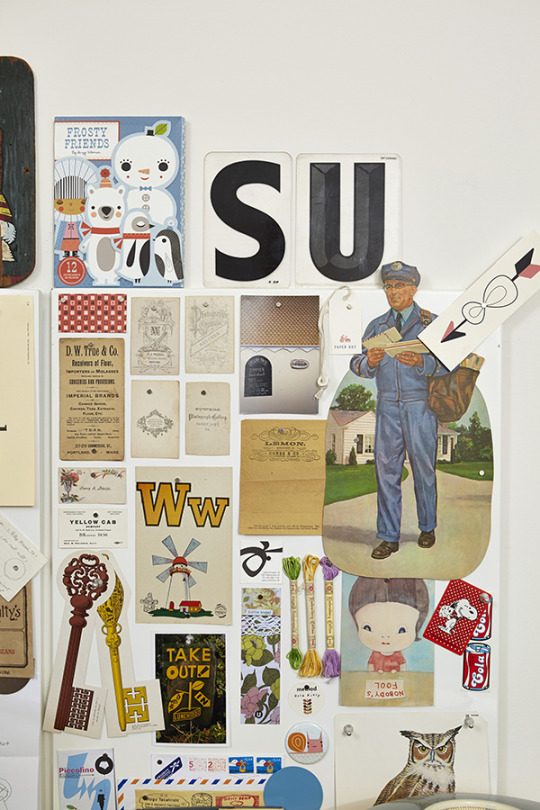

SKETCHY BEHAVIORS | Interview with SUZY ULTMAN
Growing up doodling, cutting out Peanuts comic strips, and sifting through the fabric from her mom’s sewing room, it is no wonder that artist, illustrator, and designer Suzy Ultman creates super fun, creative, and adorable drawings and patterns. We’re excited to find out more about Suzy and her work–from how one class changed her trajectory to some great tips on those looking to follow in her footsteps!
Photographs courtesy of the artist.
Who are you and what do you do?
Hi! My name is Suzy Ultman -- I'm an artist/illustrator/crafty girl, working, living, and playing in the Midwest. So far in my life, I’ve lived East Coast, West Coast, Midwest, and on 3 continents. My broad travels, love of nature, and soft spot for musicals have influenced my colorful, optimistic style.
How did you first get into drawing and doodling?
I’ve been doodling since I can remember. At about age 10, I started cutting out the Peanuts comic strips from the Sunday newspaper, and taping them into my scrapbook. Then, I’d spend hours upon hours drawing Snoopy. I also loved making doodles of food packages, making collages of magazine bits, creating my own bubbly typefaces, and writing & illustrating little stories & poems.
When did that lead you to creating your own illustrations and works ?
In high school, I discovered a talent for visual problem solving in a senior graphic design class. This led to undergrad and graduate work in graphic design, and a career in the field. Then, about 10 years ago, a close friend encouraged me to join a studio class taught by an agent, Lilla Rogers. I had just moved to Boston and was in temporary housing with 2 small kiddos. I found a sitter and committed to the course. At the end of the 8-week class, Lilla encouraged me to draw, draw, draw. I threw myself into creating my illustration portfolio. I’ve been drawing for a living ever since.
When you’re working on something new, either if it’s a pattern or a pin, what is that process like?
I approach every project the same: (1) Work as a team with the client (2) Find the story in the project (3) Have fun & play (4) Present a clear concept with a Suzy “wink”.
You create some really cute and fun patterns, what’s your interest or relationship with textiles? Have you always had an interest in making your own art into wear?
Growing-up, I loved spending time in my mom’s sewing room, looking through her piles of fabric, and hunting through her notions drawer for buttons. I’d collect bits of treasure, and make dolls & objects from whatever I could get my scrappy hands on.
With my fabric collections, I get to design textiles that will become a palette for making. It’s fun to imagine the endless possibilities that will be created from the fabric.
What’s one of your favorite creations you’ve made and why?
“Mr. Sun & Friends” wooden character set is one of my favorite creations. My client, PSikhouvanjou, urged me to follow my imagination. With that freedom, the characters came to life very organically — that’s always a pleasure! Also, I love telling a story through product design, and thinking about the ways the audience will relate to the object. By designing “Mr. Sun” to be attractive to children & whimsical adults, we created a toy for both play & display. It’s been wonderful to see how people have adopted these friends into their homes. For me, creating a product that brings joy, connects the family, and has a long shelf life in the home is a great feeling.
Do you keep a sketchbook or work your ideas as you go along? What type of things keep you inspired or are inspired by?
I have a sketchbook of drawings & doodles, and lots of little lists.
My studio wall is tacked full of inspiration which I’m constantly revisiting as I rotate through my collections. It’s an eclectic assortment of vintage, Dutch, Scandinavian, and Japanese ephemera, clippings, and fabric. I’m attracted to the clean beauty of Scandinavian design, and the rich storytelling of traditional folk art. I also love the textures and colors used in 1950s/60s cartoon background art.
My collections, along with spending time in nature, my family & friends, and traveling inspire my visual aesthetic.
What are your main art tools? Is there a medium you’re wanting to try but haven’t had the chance too yet?
I’m happiest with a fine pen, a wavy brush pen, markers, and watercolors. I’d love to get my hands on pottery in the near future!
Who are some artists that you’re inspired by and have influenced you throughout the years?
Mary Blair, Charles Shultz, Ed Emberley, Dick Bruna, Fiep Westendorp, Jim Henson, Seymour Chwast, Ben Shahn, Alexander Girard, Jonathan Adler, Yoshitomo Nara
Who are some artists you’d love to see us interview?
Carolyn Suzuki, Seonna Hong, Kelly Thorn
When you’re not working in the studio, what are you doing? What do you enjoy?
When the weather is nice, I have my coffee outside every morning, and watch the birds. On the weekends, you’ll find me whipping up a batch of hummus (extra garlic, please) or searching for the perfect brownie recipe. I enjoy building a fort with my boys, and taking them for a walk in the woods. I love the local book shops, vintage clothing stores, and antique malls. I meditate — often.
What do you think you’d be doing if you weren’t an artist? What career path would you have chosen?
I’d like to help people in vulnerable situations, possibly hospice care or an art therapist for children.
What would you tell someone who wants to follow in your footsteps?
Be yourself.
Make plans, but know that some of the best things that happen are completely unplanned.
Don’t take rejection personally. There are a lot of things behind the scenes that are out of your control. Just keep on keeping on.
Don’t be afraid to ask questions.
Create a community/support network.
What are your FAVORITE Vans?
Slip-ons for easy action.
Finally, can you tell us about any exciting things you’ve got coming up?
I can’t talk to you about any upcoming projects, but we are taking our annual family vacation to Canada very soon. I LOVE a roadtrip, so there will be plenty of snacks and books on CD. Yes, CDs — that’s how we roll!
FOLLOW SUZY | WEBSITE | INSTAGRAM
#Art#Vans#Vans Girls#Vans Art#Sketchy Behaviors#suzy ultman#interview#female artists#pattern#design#creativity#inspiration
42 notes
·
View notes
Text
LUCY: 40 YEARS OF TELEVISION
1954 Part One ~ JANUARY to JUNE

Season three of “I Love Lucy” concludes with another Emmy win for the series and for Vivian Vance. February would see the premiere of the film “The Long, Long Trailer.”
"The Million-Dollar Idea" (ILL S3;E13) ~ January 11, 1954

Lucy takes a page from Jackie Gleason with this get-rich-quick scheme selling salad dressing on television! Frank Nelson is back as yet another TV host, Dickie Davis. Filmed November 26, 1953.
"Ricky Minds the Baby" (ILL S3;E14) ~ January 18, 1954

Ricky takes a page from “Father Knows Best” when telling a bedtime story to his son. To assure that the potential crying of the Mayer Twins (Little Ricky) didn’t hold up the filming, this is one of the few episodes not filmed in front of a live audience. Filmed December 3, 1953.
"The Charm School" (ILL S3;E15) ~ January 25, 1954

Best remembered for Natalie Schafer (”Gilligan’s Island”) as Charm School proprietress Phoebe Emerson. The week before this episode first aired, Schafer made an appearance on CBS TV’s "Topper” as a character named (coincidentally) Mrs. Vance. Filmed December 10, 1953.
"Sentimental Anniversary" (ILL S3;E16) ~ February 4, 1954
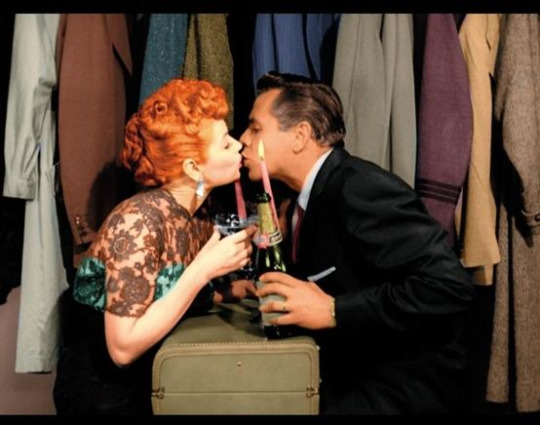
This episode was filmed on December 17, 1953, just two weeks after Desi surprised Lucy with a 13th wedding anniversary party at the Mocambo. Includes real snapshots of Lucy and Desi that were taken from Lucille’s dressing room! Despite the color photo above, the episode was shot and aired in black and white and has not (to date) been colorized.
"Fan Magazine Interview" (ILL S3;E17) ~ February 8, 1954
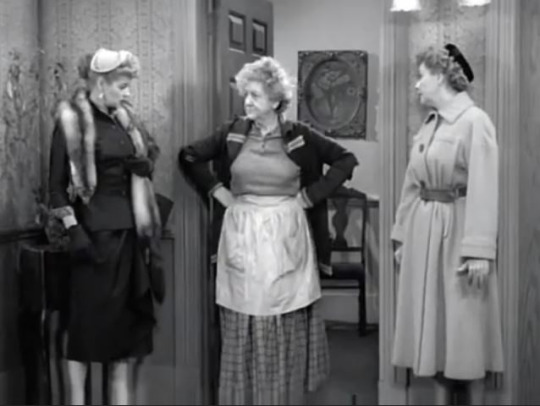
This episode marks the first appearance of Kathryn Card as Minnie Finch, although she would be best remembered for playing Lucy’s mother, Mrs. McGillicuddy. Best remembered for a joke about the controversial Kinsey Sex Study. The first episode filmed after the holiday break, on January 7, 1954.
“Sixth Annual Primetime Emmy Awards” ~ February 11, 1954

Only broadcast on local television station KHA (aka KCLA-TV). The series won for Best Situation Comedy, as did Vivian Vance for playing Ethel Mertz. Lucille was nominated but lost to Eve Arden in “Our Miss Brooks” (ironically filmed at Desilu Studios). William Frawley lost to Art Carney as Ed Norton on “The Honeymooners.”
“Toast of the Town: The MGM Story" ~ February 14, 1954

Lucy and Desi appeared on Ed Sullivan’s show to mark the 30th Anniversary of Metro Goldwyn Mayer (MGM). Three days later, their MGM color film The Long, Long Trailer premiered.
"Oil Wells" (ILL S3;E18) ~ February 15, 1954

It was a bit of a stretch for the Ricardos and Mertzes to strike oil in midtown Manhattan, but that didn’t stop the writers! Featuring Sandra Gould, who is probably best remembered as the second Gladys Kravitz on “Bewitched” (1966-1971). Filmed January 14, 1954.
“What’s My Line? (S2;E25) ~ February 21, 1954

As Mystery Guest, Lucille Ball uses the same voice she created when she played a Martian at the top of the Empire State Building in “Lucy is Envious” (ILL S3;E23). Host John Daly tells the panel that Lucy is speaking Martian. That episode was filmed on February 16, 1954 just five days before this quiz show.
"Ricky Loses His Temper" (ILL S3;E19) ~ February 22, 1954

Includes an appearance by Madge Blake (Aunt Harriet on “Batman”) as Mrs. Mulford, who owns the hat shop Lucy patronizes. Famed Western ventriloquist Max Terhune makes a brief appearance with his dummy, Elmer Sneezeweed! Filmed January 21, 1954.
"Home Movies" (ILL S3;E20) ~ March 1, 1954
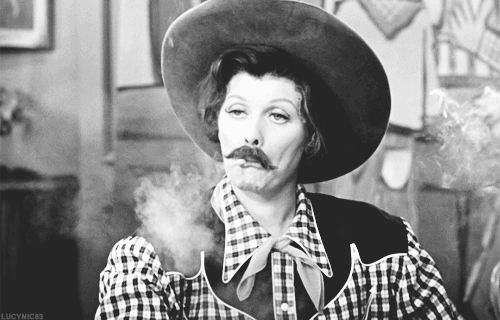
Home movie technology was new in the 1950s, but that doesn’t stop Ricky. Due to logistics, this episode was filmed (January 28, 1954) without a studio audience. Once the gag reel of Ricky’s audition had been created, the entire episode was shown to an audience and their laughter recorded for the final broadcast. Includes the songs “Vaya Con Dios” and I’m An Old Cowhand (On the Rio Grande)”.
"Bonus Bucks" (ILL S3;E21) ~ March 8, 1954
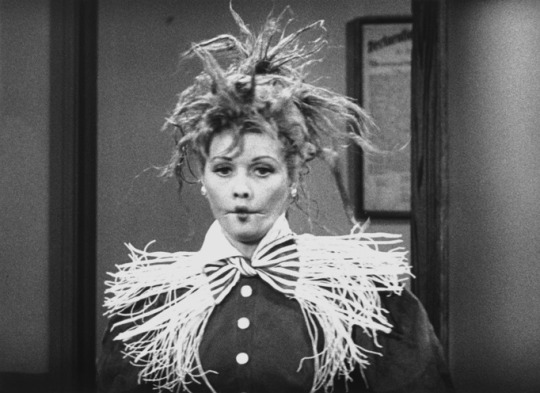
The episode was inspired by the popular newspaper contests of matching serial numbers on a bill which were called ‘Lucky Bucks’ but due to the show’s sponsorship with Philip-Morris cigarettes, the word ‘Lucky’ [as in Strike] was to be avoided. Once again Lucy tries to outpace a speedy conveyor belt, this time one that leads to a laundry starch vat! Filmed February 4, 1954.
"Ricky's Hawaiian Vacation" (ILL S3;E22) ~ March 22, 1954

Hawaii was a favorite get-away for the Arnaz family, but the Ricardos never leave their living room. Includes Frank Nelson reprising his role as quiz master Freddie Fillmore hosting a TV show called “Be A Good Neighbor.” Lots of physical comedy by Lucy adds to the fun! Filmed February 11, 1954, the same day that the show won its second Emmy.
"Lucy Is Envious" (ILL S3;E23) ~ March 29, 1954

“It’s a moo-moo!” Inspired by Orson Welles’ “War of the Worlds” radio broadcast, Lucy and Ethel take a promotional gig as women from Mars atop the Empire State Building! Mary Jane Croft makes her first appearance as Cynthia Harcourt, the socialite Lucy is envious of, and Herb Vigran plays the publicity agent who hires the girls. Filmed February 16, 1954.
"Lucy Writes a Novel" (ILL S3;E24) ~ April 5, 1954
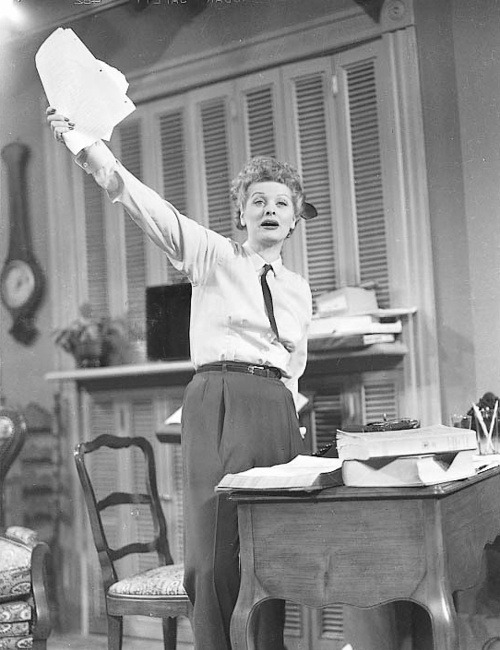
Having already tackled a play (”A Tree Grows in Havana” / “The Perils of Pamela”) and an operetta (”The Pleasant Peasant”), Lucy tackles a novel, a roman a clef she titles “Real Gone With the Wind.” Filmed March 4, 1954.
"Lucy's Club Dance" (ILL S3;E25) ~ April 12, 1954
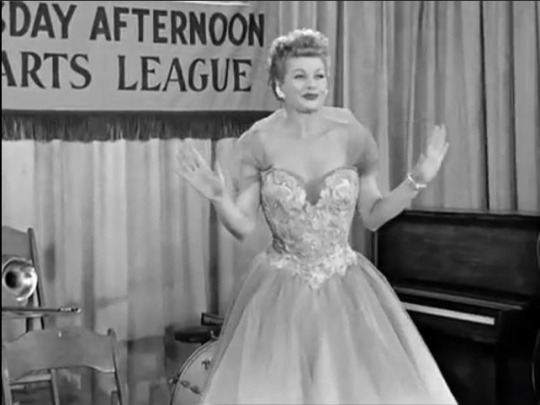
This episode was rerun in season five with a new opening that set the rerun up as a flashback. Lucy is back on the sax and TV Guide gets some publicity as a thank you for putting Desi Jr. and Lucy on their first national edition’s cover. Filmed March 11, 1954.
"The Black Wig" (ILL S3;E26) ~ April 19, 1954

Inspired by the Italian film stars of the time, Lucy wants her hair short and dark. While Ricky disapproves, he (amazingly) fails to recognize her setting off an elaborate charade to test his fidelity; one that ends up with Ethel dressed up “like a trip around the world.” Filmed on March 24, 1954, in black and white, despite the colorized photo above.
"The Diner" (ILL S3;E27) ~ April 26, 1954

This episode and the “The Black Wig” (ILL S3;E26) had their filming and broadcast order switched so that Bill’s Diner ended up becoming the set for Tony’s Restaurant where black wig Lucy and Geisha/American Indian/Eskimo Ethel meet Ricky and Fred for their fake blind date. The episode ends in true vaudevillian comic style with everyone getting a cream pie in the face.
"Tennessee Ernie Visits" (ILL S3;E28) ~ May 3, 1954
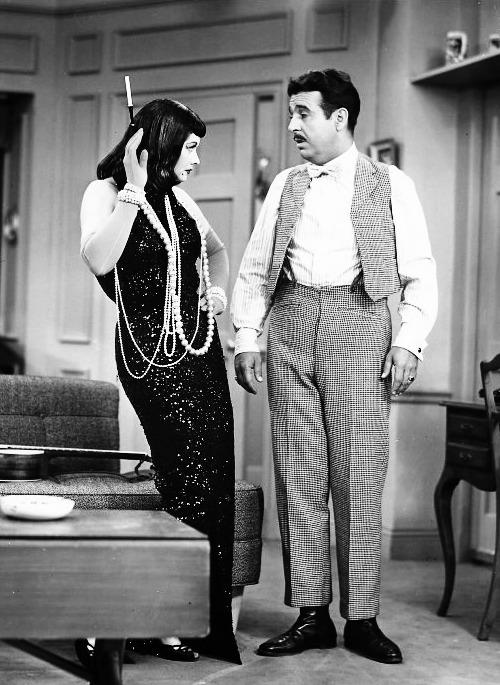
The first of two linked episodes guest-starring country music personality Tennessee Ernie Ford. Not only would he return during season 4, he would guest-star on “The Lucy Show” and “Here’s Lucy.” This is the first mention of Mrs. McGillicuddy, Lucy’s scatter-brained mother. Filmed April 1, 1954.
"Tennessee Ernie Hangs On" (ILL S3;E29) ~ May 10, 1954

Lucy tries everything to get rid of her country-fried house guest. The finale finds Ernie and the gang on television singing “Y’All Come!” Filmed April 8, 1954.
"The Golf Game" (ILL S3;E30) ~ May 17, 1954
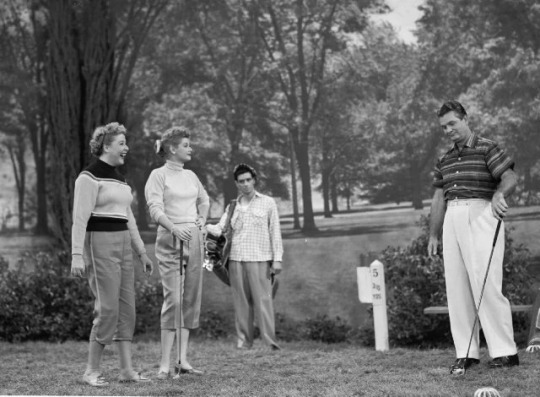
Lucille Ball was a golf widow on camera and off. Desi Arnaz even built a home on a golf course. Even her second husband Gary Morton was addicted to the game. This episode features real-life golf pro Jimmy Demaret. He returned for another golf-themed episode on “The Lucy Show.” Filmed April 15, 1954.
"The Sublease" (ILL S3;E31) ~ May 24, 1954
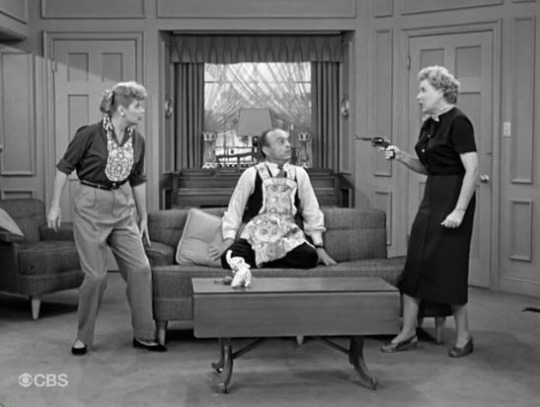
So that the Ricky can take a booking in California, the Ricardos sublet their apartment to Mr. Beecher (Jay Novello) who jumps at his own shadow. When the booking falls through, Lucy goes to extremes to get Mr. Beecher out! Filmed April 22, 1954.
ALSO IN 1954...
“THE MILTON BERLE SHOW” (S6;E23) ~ May 4, 1954

Berle's guests include Vivian Vance and William Frawley from “I Love Lucy” (1951) and singer/actress Janet Blair. Miltie rents a new rehearsal hall from landlords Fred and Ethel Mertz. Lucille Ball and Desi Arnaz do not appear.
#1954#CBS#TV#I Love Lucy#Lucille Ball#Desi Arnaz#Vivian Vance#William Frawley#Jay Novello#Jimmy Demaret#Tennessee Ernie Ford#What's My Line#Toast of the Town#Ed Sullivan Show#Emmy Awards#Kathryn Card#natalie schafer#Ed Sullivan
3 notes
·
View notes
Text
Labour unveil taxes on homeowners who have a garden and forces of sale of land on the cheap | Daily Mail Online
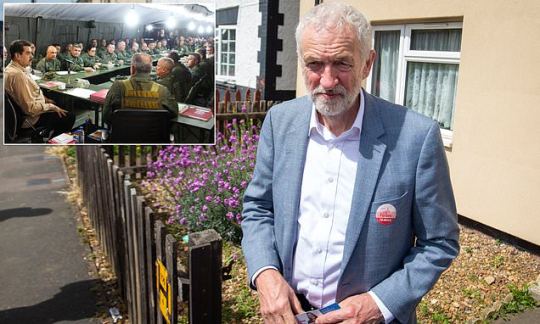
Labour was accused of pursuing the policies of Venezuela last night as it unveiled plans for a tax raid on middle-class homeowners and powers to force landlords to sell on the cheap.
A report, called Land for the Many, said council tax should be replaced with a new 'progressive' levy targeting larger homes with gardens.
And it suggested scrapping the single person discount – which gives widows and others 25 per cent off their bill. The blueprint, commissioned by Labour, also put forward radical reforms such as taxing land owned by foreigners and building thousands of council houses on public land.
Labour was accused of pursuing the policies of Venezuela last night as it unveiled plans for a tax raid on middle-class homeowners and powers to force landlords to sell on the cheap. Pictured: Labour leader Jeremy Corbyn
And it called for Britons to be forced to attend town hall planning meetings in the same way they have to go on jury service.
Labour frontbencher Jon Trickett said he would consider the proposals, which he said would tackle the 'concentration of land in the hands of the few'.
However, Tory MP Priti Patel accused the party of 'state-sponsored theft'. The former Cabinet minister said: 'This is confirmation that Labour would bring the policies of Venezuela to Britain.
'These are the policies of a banana republic with a disregard for property rights.'
David Prescott, 49, (right, left, his father John) a close aide to Mr Corbyn, was allegedly accused by a young female Labour MP of making 'unwanted sexual advances' in November 2017.
Labour staff in revolt after Jeremy Corbyn blocked the suspension of John Prescott's son over sexual harassment claim
More than 100 Labour staffers wrote to Jeremy Corbyn last night to demand he get the party’s ‘house in order’ over sexual harassment.
They demanded action over claims that the Labour leader’s office blocked the suspension of John Prescott’s son following a complaint of alleged sexual harassment.
David Prescott, 49, was allegedly accused by a young female Labour MP of making ‘unwanted sexual advances’ in November 2017.
According to reports, Mr Corbyn’s chief of staff Karie Murphy intervened to overturn a recommendation that he be suspended from Labour membership.
He has strenuously denied the allegations. No formal complaint was pursued and he returned to his role in the Labour leader’s office.
Yesterday, Labour staffers wrote an open letter to Corbyn asking him to overhaul the party’s system for handling complaints.
They wrote: ‘Working in politics isn’t easy, and many of us choose to give up our personal lives for Labour because we believe it is the best force for good in our country.
‘What makes the job even more challenging than it should be is having to work in an environment where sexual harassment and bullying are not taken seriously.’
Labour has said it takes all complaints extremely seriously.
‘In this case, no formal complaint was received to investigate,’ a party spokesman said.
MPs have urged the party to make its complaints procedure entirely independent to avoid accusations of factionalism in dealing with complaints of harassment or racism and anti-Semitism.
The MPs Jess Philips and Stella Creasy have said the party must carve off its complaints arm, rather than use the current system where the bodies making final decisions about the complaints can be elected on factional slates.
A newspaper and television journalist - who helped write his father’s now-defunct column for the Sunday Mirror - Mr Prescott is a seasoned political operator who has worked with, among others, Tony Blair’s spin doctor Alastair Campbell.
When talking up his private media training business, which he ran before taking up his role with Labour in late 2016, he took credit for the campaign that resulted in disgraced Royal Bank of Scotland chief executive Fred Goodwin handing back £4.7million of his pension.
Venezuela's economy has been driven into political and economic crisis by hard-Left policies admired by Jeremy Corbyn.
The report, written by academics and economists, was commissioned by Labour to address 'the problems and injustices of British society'.
It said the 'regressive and unpopular' council tax should be replaced by a new progressive property tax based on regularly updated property values that would hit the top 40 per cent of property by value.
Rates would be set nationally rather than by local councils, meaning regular inspections by state officials.
The report accused the single person discount of encouraging the 'over-consumption of housing'.
It also called for town halls to make more use of compulsory purchase orders on land needed for building – and said they should be allowed to buy the land at a much cheaper price than at present.
Councils would be given the power to require land that has been left vacant or derelict for a defined period to be sold at public auction.
Changes to existing laws would enable them to buy at prices closer to its current use value, rather than potential future residential value.
In order to ensure poorer families have a voice in the process, it said everyone should be eligible for jury service-style attendance at planning meetings.
Among the other policies, a 'community right to buy' would make it easier for residents to band together to purchase land. Firms based abroad who own land in the UK would face a new offshore company property tax.
Mr Trickett, Labour's spokesman for the Cabinet Office, said: 'For too long, people across the country have had little or no say over the decisions that affect their communities and the places in which they live.
'So much of this can be traced back to the broken system of land ownership. Concentration of land in the hands of a few has led to unwanted developments, unaffordable house prices, financial crises and environmental degradation.
'Labour is committed to tackling these head on and delivering a fundamental shift in wealth and power from the few to the many.'
Housing Secretary James Brokenshire said: 'These proposals are extraordinary and deeply damaging in equal measure. Labour will stop at nothing to hammer families with more tax and make home ownership a pipedream for future generations.
'Plans to seize land into public ownership also show Labour's true colours of more and more state control. This tax bombshell for families would mean family homes with gardens paying far more and higher taxes on pensioners by abolishing the single person discount.'
ALEX BRUMMER: A frightening move straight from the autocrat playbook
Among all of Labour's crackpot schemes to destroy free market capitalism in Britain, none is more frightening than the proposed 'grab' of private land that the party has just unveiled.
It is a move straight out of the Marxist playbook, a tactic regularly deployed by autocrats the world over with the aim of burnishing their revolutionary credentials – with dramatic consequences. What Labour is determined on is a new age of collectivism. Well, we know how disastrously that worked out in the former Soviet Union and elsewhere – famine and starvation.
For modern day examples, look no farther than Zimbabwe and Venezuela, where the confiscation of large swathes of property from the landowners to be gifted directly to workers led to collapsing food production, economic slump, and was a factor in the hyper-inflation and widespread poverty that followed.
The proposed 'grab' of private land that Jeremy Corbyn's Labour party wants has chilling echoes of the policies of former Zimbabwe leader Robert Mugabe (right)
In a sophisticated nation such as Britain, where international investors have bought property as a safe investment haven, the impact could be even more devastating.
Even the threat of Jeremy Corbyn's apparatchiks interfering in the free market by stopping the sale of land to the highest bidder is enough to scare off buyers and cause values to collapse.
Of course, Labour would argue that is the aim – 'land for the many, not the few'. In reality it shows the party's utter economic ignorance.
For example, under current arrangements, local authorities or infrastructure companies such as HS2, which is building the high speed rail link between London and Birmingham and on to Manchester, are required to compensate land and home owners affected by the development at market values.
Corbyn and his team, headed by shadow chancellor John McDonnell (pictured) would buy land at its current (and always lower) 'land use value' rather than at a market price which recognises the uplift that development can bring
Corbyn and his team, headed by shadow chancellor John McDonnell, want to change that. They would buy land at its current (and always lower) 'land use value' rather than at a market price which recognises the uplift that development can bring.
This could trigger a financial crisis. Much of the nation's potential land for development is owned by housebuilders, property companies and institutions such as insurers and pension funds.
Some of these development holdings will have been bought or financed on credit from the banks. If land values plummet, banks will be left with a black hole on their books.
A lending freeze might follow, bringing commerce to a shuddering halt, since credit is what keeps corporate Britain moving. That could lead to cascading business closures and a return of large scale unemployment. Even worse, those financial institutions most exposed to property could collapse, destroying the savings of millions. Almost as alarming is Labour's proposal for an offshore property company tax, a huge deterrent to overseas investors from Asia, the Middle East and closer to home in Norway and Germany.
No one could blame them for pausing their investment in Britain.
What Labour seems oblivious to is that property development is a fundamental building block of our services- led economy.
Of course, it is not the first time that Labour has threatened such action. In the run-up to the 2015 election, the then Labour leader Ed Miliband provoked a firestorm when he told property developers to 'either use the land or lose the land'. Business leaders described it as 'Stalinist threat to property rights.
The land grab agenda of today's party leadership goes much further.
Labour is cloaking its proposals in the disguise of being 'good for communities', arguing that challenging land ownership will deliver a fundamental shift in wealth and power.
This ignores the fact that one of the fundamental principles on which social solidarity in Britain rests is that of a property-owning democracy.
Indeed, this was one of the underpinnings of the Thatcherite revolution which allowed council home residents, many of them Labour loyalists, to buy a property and take control of their own bit of Britain.
It is no exaggeration to say that the UK's green and pleasant land – by the way, Labour plans on appropriating agricultural land for 'small farmers' too – is under threat as never before.
And our hard-earned status as the fifth most prosperous country in the world could be imperilled.
It is with good cause that a Corbyn government is already regarded as more frightening than a No Deal Brexit by entrepreneurs, business and overseas investors
This content was originally published here.
0 notes
Text
Andaman Journalist Says Administration Out to 'Teach Him a Lesson' for Asking Questions
New Delhi: Andaman and Nicobar Islands-based freelance journalist Zubair Ahmed, who was booked under multiple charges for a tweet that questioned the union territory’s quarantine protocol, was granted bail on Tuesday afternoon, soon after he was produced in court.
Ahmed had posted a tweet that claimed that some families were forced to quarantine after they spoke to some COVID-19 patients on the phone. The police said his claim was untrue – even though the local newspaper, Andaman Chronicle, had reported on such a case the day before – and booked him under multiple charges like disobedience against an order by a public servant and negligent acts that aid the spread of a contagious disease. The UT’s DGP Deependra Pathak said that his comments could have spread panic among residents, and fomented communal tensions in the Islands.
Can someone explain why families are placed under home quarantine for speaking over phone with Covid patients? @MediaRN_ANI @Andaman_Admin— Zubair Ahmed (@zubairpbl) April 26, 2020
Among the multiple charges, the police also booked him under Section 505 (1) of the IPC, which is a non-bailable offence and entails imprisonment of up to three years for circulating fake information. However, after Ahmed’s counsel Mohammad Tabrez challenged the non-bailable section, the court agreed and granted him bail.
Ahmed was in custody overnight before he was granted bail. Soon after he walked out, Ahmed said that the administration wanted to “intimidate” him to “teach him a lesson” for asking critical questions.
“It looked like everybody there was ready to lock me up. Otherwise, why would they make me travel so far via a ferry from one police station to the other? They made me go from a red zone police station, i.e. the Bambooflat station which is about 4 km from my house, to the Aberdeen police station which is in a non-containment zone. The officials said the superintendent of police wanted to question me. But nothing like that happened. All they wanted to do was to teach me a lesson,” Ahmed told The Print.
Ahmed was arrested by the Bambooflat police before being taken to Aberdeen. According to a Newslaundry report ,Ahmed first received a call on the morning of April 27 from the Aberdeen police station, asking why he had posted his comment in the “public domain”. Ahmed said he told the police official that he posted the tweet because the authorities were not making themselves available for a comment.

Port Blair, Andaman and Nicobar Islands.
However, as he prepared to pray after breaking his Ramzan fast that evening, a team of police officials from Bambooflat police station, which is supposed to oversee his village, came to his house at around 7.30 pm. The officials told him that the district superintendent wanted to meet him. Only after accompanying them to the police station, he realised he had been arrested when his phone was confiscated and sealed.
“Twitter is a medium where I could ask, so I asked the question there. Posting on Twitter isn’t creating any panic,” he told the news portal, on a phone that he borrowed from his relative after getting bail.
“If the media is asking questions, why can’t they properly respond? Instead of clarifying, this is the new method (arresting journalists) they have taken. They target you. Everyone wants to fight the coronavirus. But if you ask questions, you become an enemy of the state and, somehow, against the corona warriors. It all comes in a package. That’s the problem,” he said.
Regarding his claim that families were being forced to quarantine for speaking to COVID-19 patients even on phone, he told The Print, “There has been news of people put under home quarantine for speaking on call to relatives who tested positive for coronavirus. But these families haven’t even been in physical contact with the patients. Why put them under quarantine then?”
He had posted two tweets on Sunday and Monday, asking officials why people were being quarantined on speaking to COVID patients on phone. He said that the tweets were more like queries rather than a comment on administrative conduct.
Ahmed said that the police officials have directed him to “not to write any post” on Twitter.
Read the full article
0 notes
Text
Sheldon Weldon (1944 – 2017)

Wine writer Sheldon Weldon has died of nefarious ankles at the age of 73. He was famous for his witty prose, which effervesced with elements of lyricism and nutmeg, giving way to subtle undertones of bathos and orchard fruits.
Born in Dripping Plodhampton, Weldon’s upbringing was conventional for the time, with overwhelming aromas of fragrant honeysuckle giving way to the delicate permeation of a fourth-grader’s hamster cage. He left school at 16, and started writing for the local newspaper, the Plodhampton Aggravator.
Beginning with local news reporting, Weldon began reviewing restaurants for the publication when its long-standing food writer Angus Strop was accidentally executed by a Belgian firing squad. Weldon later described the opportunity as “a stroke of luck, with tempting notes of elderflower and a chalky aftertaste.”
Weldon’s restaurant reviews became more and more popular with the Aggravator’s readership, and in 1965 he was offered a chief writer position at the national wine publication, Vinyard Infiltrator.
Over the years, Weldon wrote wine reviews for a number of newspapers and magazines, including the Guardian, Glug Glug Spit Fortnightly, Oenalysis, and Grapefelch. His writing style was full-bodied, with hints of sherbet and iodine, like a peaty hospital dessert.
In 1988, Weldon achieved national notoriety in the UK when, having imbibed slightly more than usual at a gala tasting event, he attempted to decant and drink Princess Michael of Kent. She described the experience as “unpleasant for the most part, but giving way to surprising aspects of licorice and brambles.” Weldon was freed when she declined to press charges.
Away from the wine world, Weldon had many hobbies, including amateur necromancy and mail fraud. He married his first wife, Blair, in 1965, but they divorced six years later, citing a relationship that was “cold and unfeeling, with a short finish and inexplicably light tannins.”
Sheldon Weldon, wine writer, born January 21, 1944, died August 21, 2017. The funeral will be on Friday at the car park, BYOB
#wine#wine writing#BYOB#obituary#fake obituary#hi#been a while eh#princess michael of kent#amateur necromancy#mail fraud#vinyard
40 notes
·
View notes
Text
New from Every Movie Has a Lesson by Don Shanahan: 20 YEAR RETROSPECTIVE: The best of the rest of 1999
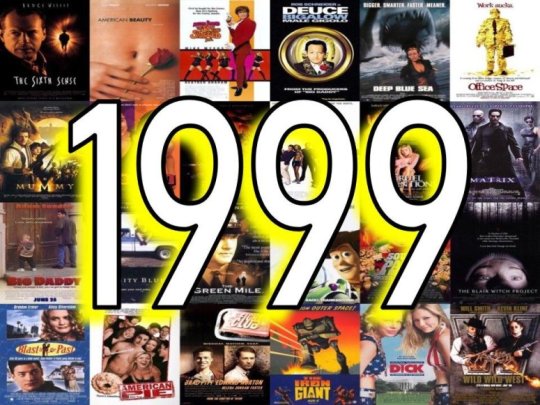
(Background image: twitter.com)
In an annual series, Every Movie Has a Lesson is going to look back twenty years to revisit, relearn, and reexamine a year of cinema history to share favorites, lists, and experiences from the films of that year.
As I was saying one column earlier when I laid out my absolute Top 20 from 1999, I was a 20-year-old undergrad Elementary Education major at Saint Joseph’s College twenty years ago. I was a country kid absorbing cable television for the first time, working at a local video store, writing movie reviews for the college newspaper. I was devouring movies new and old and the rural boundaries of Rensselaer, Indiana or my activity time as the football equipment manager didn’t stop me. On football road trips, I was more or less “staff” where I wasn’t bed-checked like the players. I used to go out after hours, pre-Uber and without a cell phone, and scout ahead the closest movie theater to the team hotel in order to find ways to see movies on opening Friday nights. Man, that was living.
As the historians will tell you, 1999 was a damn fine year. There are many films from that year that count as favorites and greats in several different ways. Some have gotten better with age and some have worsened, even dropping at as former favorites. Here are my little breakdowns of the “rest of 1999.” Enjoy!
Personal Favorites
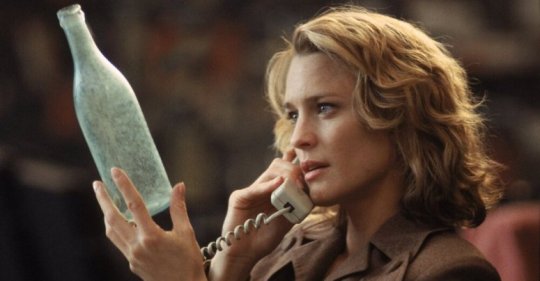
(Image: justwatch.com)
Message in a Bottle, Entrapment, Deep Blue Sea, The 13th Warrior, The Mummy, Double Jeopardy, Life, Star War: Episode I – The Phantom Menace, The Best Man, The Bone Collector, Bicentennial Man
My 1998 retrospective last year will show you that I am an absolute softy for a romantic genre. My first taste of anything Nicholas Sparks came in movie form and it was the Kevin Costner-starring Message in a Bottle. This might have been my #2 favorite movie of 1999 in the college newspaper behind The Green Mile and I swallow a minute amount of shame. I still love this one. Kostner is a lifetime favorite of mine and his pairing with Paul Newman set against melodrama with rich production values (that Caleb Deschanel cinematography and Gabriel Yared score still get me) was gold for me.
Along the same lines, 2014’s The Best Man Holiday made me re-fall-in-love with The Best Man, a favorite that has only gotten better. Sappy Robin Williams has a limit, but Bicentennial Man can still arouse bigger sci-fi thoughts I appreciate. I’ll never grow tired of the best big-screen WTF moment of that year with Deep Blue Sea and its Samuel L. Jackson swerve.
The 1990s were the peak of the “mid-budget programmer,” studio-backed star vehicles with easy budgets, proven talent, and often genre content risks. Many of those became your steady diet of basic cable entertainment years later before reality TV took over. I’ll gladly put on the likes of Entrapment, Deep Blue Sea, Double Jeopardy, Life, Bicentennial Man, and The Bone Collector over many of today’s straight-to-Netflix films of the same budget level. The old stuff is so much better. The 90s also did blockbusters pretty damn well for its time too where I have no problem still enjoying Star Wars: Episode !- The Phantom Menace (just turn on Darth Maul and those John Williams choir voices) and The Mummy. Story came before effects still and it shows.
Guilty Pleasures

(Image: youtube.com)
Varsity Blues, Any Given Sunday, American Pie, She’s All That, Simply Irresistible, Cruel Intentions, 10 Things I Hate About You, Austin Power: The Spy Who Shagged Me, The World is Not Enough, Lake Placid, Galaxy Quest. The Boondock Saints
Speaking of those mid-budget programmers, the next class down was the lost art of the “high school movie.” The 1980s has John Hughes and the 1990s had the R-rated raunch phase that pushed further what the 80s started. Made for virtually pennies with mostly unknown talent or TV stars, these movies raked at the box office with the youth of the day, myself included. Honestly, they don’t make these kinds of movie anymore. Hell, they couldn’t get made today with the same landscape and lenses. Six years ago, I wrote an editorial here on Every Movie Has a Lesson on that phenomenon and it feels even more true in 2019. The raunchy teens grew into the “man-child” movies of the 2000s and 9/11 made everyone grow up into a wiser political culture since.
With that in mind, it’s probably wrong and more than a little misogynistic to enjoy the debauchery of American Pie, Varsity Blues, and even the intentional camp of Austin Powers: The Spy Who Shagged Me in 2019. Alas, I could and I do. They’re time capsules of eye-rolling fun at this point. I just can’t show these movies to my students or own children. They count as guilty pleasures, right next to James Bond films and cheesy creature features.
Not all in this section are contraband. One can argue there isn’t a 1999 movie that has aged better, surprisingly, than Galaxy Quest, which grows with esteem and fandom the more other things retread and reboot. The football fans still rightfully worship the swagger of Any Given Sunday. Pygmalion and Shakespeare students can still be proud of She’s All That and 10 Things I Hate About You (which is many folks’ introduction to the late Heath Ledger, including mine). The buried treasure I recommend the most is Sarah Michelle Geller’s Simply Irresistible, an airy and easy romance that also couldn’t be made today with the same panache. I gave that one some anniversary love this year writing for 25YL. Seek it out for a good time.
Underrated Gems
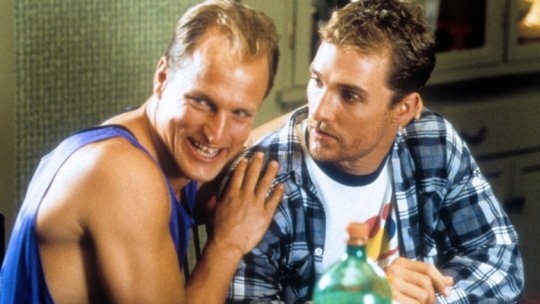
(Image: letterboxd.com)
Payback, True Crime, EDtv, A Walk on the Moon, The General’s Daughter, Summer of Sam, The Wood
Here are a few to add to Bringing Out the Dead and Ghost Dog: The Way of the Samurai which made my Top 20 in the last post. These titles are a step down from personal favorites, but movies that I find more solid than flimsy compared to the rest of the offerings from 1999. Most are more of those mid-budget programmers like Payback and The General’s Daughter, but don’t sleep on director Spike Lee’s under-seen Summer of Sam or Viggo Mortensen’s swooning Woodstock romance A Walk on the Moon. Plenty cheesy for sure, but EDtv counts as slightly ahead of its time even after trying to follow The Truman Show from 1998.
Re-Visitations Needed

(Image: rogerebert.com)
Magnolia, Eyes Wide Shut, Being John Malkovich, 8mm, Lock, Stock, and Two Smoking Barrels, Pushing Tin, Dick, Sleepy Hollow, Ride With the Devil, Girl Interrupted
With full admission, the 20-year-old version of me did not have his teeth completely cut or his eyes fully focused as a fit critic who could see past the entertainment and into the art. There are many movies on fancier “Best of 1999” lists that were simply lost on me back in their day. I recognize the impact and greatness of Magnolia, Eyes Wide Shut, and Being John Malkovich, for example, but they will always be distant. Some of them I’ve tried again. Some need another chance or two. For the others, I want to see how a few top directors’ (Guy Ritchie, Ang Lee, Tim Burton) earlier works look now against their current stuff.
Blind Spots
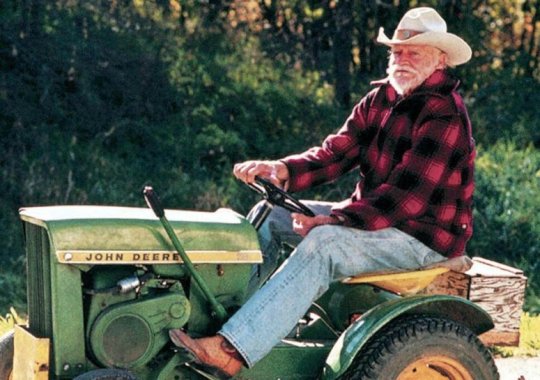
(Image: The Independent)
The Straight Story, Ravenous, All About My Mother, The Thirteen Floor, Flawless
These are the movies looking to make the queues and wish lists on platforms and streaming services so richly available to us in 2019.
Overrated
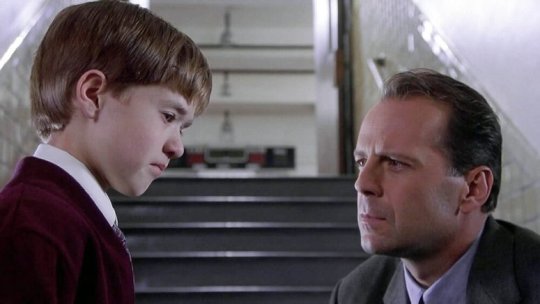
(Image: variety.com)
The Sixth Sense, The Blair Witch Project, Analyze This, Never Been Kissed, Big Daddy, South Park: Bigger, Longer, and Uncut, Mystery Men, Dogma
Alright, let me get my next umbrella to cover the crap coming to fall. I’m going to come right out and call M. Night Shyamalan’s The Sixth Sense overrated. It’s the biggest 1999 movie that has fallen out of favor for me personally. I blame the director’s degrading work since this first hit. Smart as it is, it loses a little each viewing and only exposes his twist-dependent lack of creativity. I know Mystery Men has earned a level of cult status, but I find it to be a busy mess still. The repeated crappy comedy phase since 1999 for Robert De Niro has not helped Analyze This.
After that, it’s about personal taste. I’m never been a South Park lover, TV or otherwise. Kevin Smith’s work has not aged well for me and Dogma, as bold as it was, feels like preening more than deep satire. I’m not a horror guy and couldn’t care less about the 1999’s equivalent of click bait with The Blair Witch Project. Thanks for the motion sickness, though. I’ve never been a Drew Barrymore fan, and I think Big Daddy is where Adam Sandler started to lose his edge and sink into the weak sauce territory that, other than a few moments like Uncut Gems this year, he’s never recovered from.
Still Bad
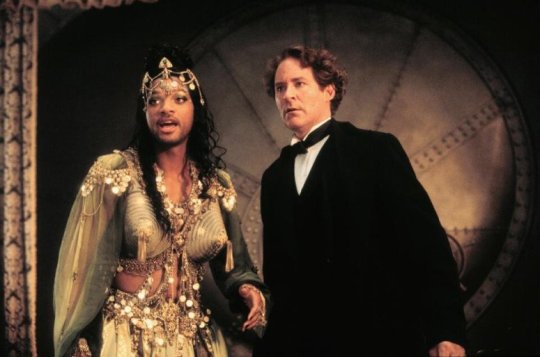
(Image: forbes.com)
Wild Wild West, Baby Geniuses, My Favorite Martian, Virus, Wing Commander, Forces of Nature, The Mod Squad, Runaway Bride, The Out-of-Towners, Bowfinger, Mickey Blue Eyes, The Bachelor, Deuce Bigalow: Male Gigolo, The Haunting
Yikes, was Wild Wild West a trainwreck! But then, we also got Wing Commander. Double yikes!
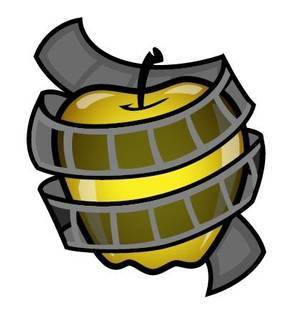
Permalink
from REVIEW BLOG – Every Movie Has a Lesson https://ift.tt/2Q4ZUZ5
via IFTTT
from WordPress https://ift.tt/2Q82wFU
via IFTTT
0 notes
Text
June 19, 2019: Columns
The ‘World’s Hottest Pepper’

By KEN WELBORN
Record Publisher
We are blessed in Wilkes to have Farmers' Markets so readily available to us.
On Fridays from 4 p.m. to 7 p.m., a group of vendors gather in front of the YMCA on Hwy. 268 in Wilkesboro. Then, on Tuesdays from 3:30 p.m. -5:30 p.m., and Saturday mornings 7:30 a.m. until noon, the Farmers' Market in North Wilkesboro is held at the Yadkin Valley Marketplace on the CBD Loop in Downtown North Wilkesboro. As more and more fruits and vegetables come in, each week they should just continue to get better and better as the season progresses.
Today I want to mention a couple of purchases I made on Tuesday afternoon of last week at the North Wilkesboro Market. As I perused the various tables, I stopped and bought a bag of peaches from Tom Lowe with the Brushy Mountain Orchard at the crest of Kilby Gap on Hwy 16 South. While there we also spent a few minutes remembering his wonderful parents, the late Jane and Caney Lowe.
As I moved on down the line, I stopped to speak to Earth and Creations owner Brenda Dembowski of Roaring River, who sells an assortment of goodies, all handmade with locally grown fruits and vegetables. As we talked, I noticed a few jars of chow chow, and, knowing that I had a pot of pinto beans about ready for dinner, I inquired about the chow chow. As I picked up a pint jar, Brenda smiled and asked, "Do you like your chow chow hot?'
"The hotter the better," I answered.
She went on to say that this stuff was really hot, and I went on to tell her that, in effect, I was tougher than woodpecker lips when it came to spicy foods and she assured me I had better be.
By now I had read the label and it said "Carolina Reaper," and when I inquired about that, Brenda said it was one of the hottest peppers ever.
Now, I will confess that a very limited number of folks are aware of the ONE time I ordered something so hot I could only eat half of it. I really think I was set up, and I did eat the rest of it the next day, so nothing was wasted. However, with that episode in mind, I must confess that I began my dinner that evening with a bit of apprehension that I may have again let my mouth overload by butt, as the saying goes.
Well, the Carolina Reaper Chow Chow was as advertised, hot, really hot; but good -it was the perfect thing to go with a good ole' pot pinto beans. As of this writing, I have eaten about half the jar, and can assure you I will not waste a bit of it. My curiosity got the best of me and I checked out this pepper and found that it is listed in the Guinness Book of World Records as the "World's Hottest Pepper," and by a long shot, at that. Actually, the fist time I typed Carolina Reaper onto the search bar a product called Blair's Ultra Death Sauce popped up.
Turns out that the pepper was developed by a man named "Smokin'" Ed Currie who owns the PuckerButt Pepper Company (no kidding) in Fort Mill, S.C. It has often been described as the initial bite actually being sweet and then turning into molten lava. It has been used to spice up any number of dishes, giving heat without changing the flavor of the original dish.
It is really becoming downright popular, and I've got to say, that Carolina Reaper Chow Chow is some good stuff.
Netanyahu Draws Strength from the Bible
By EARL COX
Special to The Record
Few people know that Israeli Prime Minister Benjamin Netanyahu readily admits that he draws his strength from the Bible. Some years back Netanyahu was interviewed on CNN. Here's an excerpt: “You live in the center of a hostile world. Are you ever able to relax?” To which the Prime Minister replied: “Yes, Sir, I am. Every Saturday on our Sabbath, I have a day off. So every Saturday, I take an hour and a half to read the Bible. I draw enormous strength as well as relaxation from this quiet time.”
As Christians, we are greatly encouraged by this admission. It is great to know that the Prime Minister of Israel faithfully spends time in the Bible, since we believe it is vitally important to understand Israel — past, present and future. The divine influence of the God of Israel is the key to the history of the Jewish people and their nation, Israel.
The interview started off with the question, “Why can’t you and the Palestinian Arabs get together?” The Prime Minister answered, “The basic problem is their failure to recognize our Jewish state.” He continued, “I am prepared to make peace with the Palestinians as we did with Egypt and with Jordan. I am prepared to have a demilitarized Palestinian state existing next to Israel. And I am prepared to meet with the Palestinians without any pre-conditions.”
The interviewer added, “So you do favor having a Palestinian state?” Netanyahu answered, “Yes, but not a state that will keep firing rockets and missiles into our land. It will have to be a demilitarized, peaceful state. And of course, they will have to recognize our state.”
When asked if he would sit down and negotiate with Hamas, Netanyahu replied: “I will sit down with anyone who will recognize our state. As you know, Hamas has refused to do that. They are true terrorists who even terrorize their own people in Gaza.” He added, “I want the world to look at what we have done in the past few years to help the Palestinians in the West Bank. We have helped them in so many ways economically.”
The interviewer went on to state that Israel’s image around the world is constantly under attack and that has to be troublesome to Israel. Netanyahu stressed that there is a big difference between the world’s perceptions and reality, saying, “Israel has suffered oppression ever since its independence, and we have never had one day of real peace, yet the world continues to see us as oppressors.” He then added, “But we are a people of peace. We have always wanted peace with our neighbors, and we still do. The truth is, they do not seem to want peace with us.”
Next came the question, “How much do you fear Iran’s intentions to destroy you?” The Prime Minister replied, “We have learned from history to take seriously their calls to destroy the Jewish State."
Netanyahu was then asked, “Would you attack Iran?” He replied, “We will always reserve the right to defend ourselves. We will always keep all options on the table.” He went on to say, “Iran is the greatest threat to humanity today. It is important to the whole world that we do not allow the most dangerous weapons in the world fall into the hands of, or be manufactured by, the most dangerous people in the world.... We cannot trust Iran to be peaceful.”
“In your lifetime," the interviewer asked, "do you think you will see peace in the Middle East?” The Prime Minister answered: “I will say yes, with conviction. Not in all of the Middle East, but I think we will have peace with the Palestinians.” He stressed, “It will take a lot of courage. We are ready now, and we hope that the Palestinians will soon also respond with the same courage.”
With Trump's "Deal of the Century" soon to be unveiled, the world will have a chance to see if the Palestinians are viable partners at the negotiating table or if Israel will again "go it alone" as they did back in 2005 with the Gaza Disengagement.
Up the Mountain
By CARL WHITE
Life in the Carolinas
It was a perfect time to visit the mountains. It always seems to be 10 to 15 degrees cooler than the foothills and even more so compared to the Sand Hills and Low Country.
Clear skies with a few clouds for a bit of contrast were above, and a winding county road was my path up the mountain to visit the quaint little town of Sparta.
When driving, I often listen to podcasts or CD’s that artists have sent or given me after or before an interview. On this day, I was enjoying the music of the group The Arcadian Wild, and as I grew closer to my destination, I noticed an increased sense of calm.
As I became mindful of this reality, the song Millstatt played with lyrics, “This must be where God comes to rest.” It was one of those moments when you feel yourself smiling, and life seems to balance out a bit.
Based on the never-ending request list, I’m not sure if God has a lot of time for much resting; however, I am confident that the rest of us are indeed most likely better off when we take time to rest, refuel and reflect. It may not be that way for everyone, but it is for me.
Soon I found myself on Main Street in Sparta. Sparta is one of those mountain towns that you are glad you found. If you like the idea of quaint streets, good people, great food options and a slower pace, then Sparta is a place for you to visit.
On this trip, I visited several of the shops in town including a charming used bookstore that always seems to have a good deal on something I can add to my Carolinas reference book. And with the Backwoods Beans Coffee Shop right down the street, it’s easy to be satisfied.
I cannot stress enough the importance of slowing down when visiting small towns in the Carolinas. When we slow down, we reap the benefits of uncovering great treasures of all sorts and delightful interactions with locals and visitors alike.
It was great visiting with Bob Bamberg, the current editor of the Alleghany News. They have been around since 1889, and they are still publishing a newspaper today. They have seen it all, or at least most of it.
A visit to the Visitors Center and Chamber of Commerce was enjoyable. I learned a lot from Executive Director Katee Hettleman, who also introduced me to “Gertie,” the artistic interactive alpaca. Sparta is known for its Fiber enthusiasts, so much so that they now host the annual Blue Ridge Fiber Fest that attracts attendees from multiple states.
There are several events throughout the year in Sparta, so if your travels bring you to this mountain town on event days, you will get a nice bonus for your travel journal.
Good news for the people of Sparta and us guests. Within a year or so, their new Street Scape program should be finished. It’s always nice to see history preserved and protected for the future.
I look forward to my next visit up the mountain, and you never know who might be taking their rest at higher elevations.
0 notes
Text
12 reasons Boris Johnson should never be British Prime Minister
THE MIRROR
The bumbling blonde Brexiteer has repeatedly shown himself unfit to lead the country. Here's why
ALL THE TIMES BORIS JOHNSON AND HIS TEAM MADE LEADERSHIP BID DENIAL
With Theresa May's departure from Number 10 now imminent, Boris Johnson is inexplicably the bookies' favourite to be the next Prime Minister.
One of the most recognisable faces of the Tory party and a leading Leave campaign figure, Boris has become a household name - and not just because of his trademark hair.
The bumbling blonde Brexiteer has repeatedly shown himself unfit for high office, with a string of offensive remarks and errors of judgement.
Here's a round up of his worst moments.

(Image: Internet Unknown)
1. When he referred to black people as 'piccanninnies' with 'watermelon smiles'
When writing about Tony Blair 's trip to the Democratic Republic of Congo in 2002, Boris Johnson said the Queen loved the Commonwealth "partly because it supplies her with regular cheering crowds of flag-waving piccaninnies".
He said Tony Blair would be "similarly seduced by foreign politeness", and "the tribal warriors will all break out in watermelon smiles".
2. When he compared Muslim women wearing veils to 'bank robbers' and 'letter boxes'

(Image: REUTERS)
Branding the religious symbol "oppressive" in an August column in the Telegraph, he claimed: "It is absolutely ridiculous that people should choose to go around looking like letter boxes."
Any female student who turned up to school "looking like a bank robber" should be asked to remove their face covering, he then added.
3. When he used racist terms to describe Barack Obama
Annoyed at the then US president wading into the Brexit debate, Johnson described Obama as a 'part-Kenyan' with an 'ancestral dislike' of Britain.
4. When he said Libya would be great once they've 'cleared away the dead bodies'
At the Conservative Party conference Mr Johnson was widely condemned after he said the Libyan city of Sirte would have aShadow Foreign Secretary Emily Thornberry said Mr Johnson's "crass, callous and cruel" joke was a "disgrace".
5. When he recited a colonial-era poem in Myanmar
Johnson was told off by the British ambassador to Myanmar when he recited the opening verse to Rudyard Kipling's The Road to Mandalay when he visited the Shwedagon Pagoda, the most sacred Buddhist site in Myanmar's capital, Yangon.
Kipling’s poem captures the nostalgia of a retired serviceman looking back on his colonial service and a Burmese girl he kissed.
The ambassador, Andrew Patrick, said between gritted teeth "probably not a good idea" and continues "not appropriate".
6. When he risked a British mum facing a longer sentence in an Iranian prison
The Foreign Secretary incorrectly said a British mum, who is being held in a Tehran prison, was training journalists when she was arrested in Iran.
His incorrect comments sparked fears the mother-of-one could face a longer jail sentence.
7. When he insulted the entire city of Liverpool

(Image: Press Association)
In a 2004 column for the Spectator, Johnson wrote that the Hillsborough disaster “undeniably” a tragedy, but continued: “That is no excuse for Liverpool’s failure to acknowledge, even to this day, the part played in the disaster by drunken fans at the back of the crowd who mindlessly tried to fight their way into the ground that Saturday afternoon.”
He continued: “The police became a convenient scapegoat, and The Sun newspaper a whipping-boy for daring, albeit in a tasteless fashion, to hint at the wider causes of the incident.”
Talking about the attitudes of Liverpudlians, he added: “They see themselves whenever possible as victims, and resent their victim status; yet at the same time they wallow in it.”
Mr Johnson travelled to Liverpool to apologise for the article in 2004, but his apology was rejected by Hillsborough Family Support Group chairman Margaret Aspinall.
8. The time he claimed to have voted when he hadn't
On the day of this month’s local elections he published - and quickly deleted - a tweet claiming to have voted Conservative, and urging his followers to do so too.
Johnson, who lives with his partner in central London, represents the west London constituency of Uxbridge and West Ruislip.
Local elections did not take place in London this year.
9. When he talked about whisky in a Sikh temple
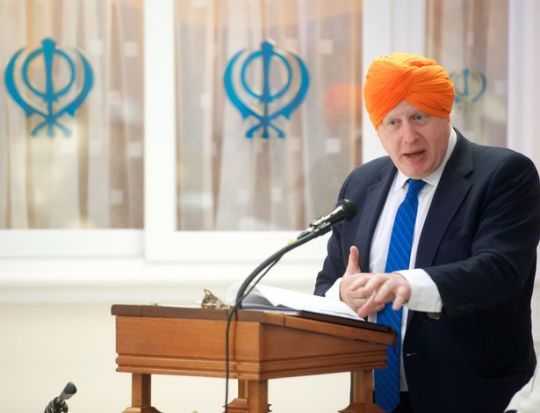
Boris Johnson blundered when he talked about whisky in a Sikh temple (Image: Bristol Post / SWNS.com)
The Foreign Secretary was berated in Bristol at a Sikh temple for talking about increasing whisky exports to India – despite alcohol being forbidden in the Sikh faith.
A voter was described as "absolutely livid" after telling the gaffe-prone Tory, who was wearing an orange turban, that it was against Sikhism.
The woman reportedly told Mr Johnson: "How dare you talk about alcohol in a Sikh temple?"
10. When he wrote a poem about the Turkish President having sex with a goat
Mr Johnson, who has a Turkish grandfather, wrote an offensive poem about Turkish leader Recep Tayyip Erdogan, accusing him of having sex with a goat.
When he met the Turkish President, he was asked by journalists at a press conference if he would like to apologise calling President Erdogan a ‘wankerer’.
Boris replied that such ‘trivia’ had not been raised during his visit.
11. When he compared the EU's aims for a superstate to those of Hitler
During the EU referendum campaign Johnson said both the Nazi leader and Napoleon had failed at unification and the EU was "an attempt to do this by different methods".
Shadow foreign secretary Hilary Benn, said the comparison was "offensive and desperate".

Boris Johnson mistakenly said Nazanin Zaghari-Ratcliffe was in Iran teaching journalists when she was arrested (Image: AFP)
12. When he reminded the Chinese that table-tennis was an English invention during the Beijing Olympics
In Beijing for the Olympic Games, Johnson said ping pong or table tennis was “invented on the dining tables of England in the 19th century. It was. And it was called wiff waff.”
He was attacked by Joe Jaques, whose great-grandfather invented ping-pong years before wiff waff in 1891, who said Boris had his facts "completely wrong".
Wiff waff was devised later by a commercial rival.
Read the full article
0 notes
Text
Sleep Overnight in ‘The Brewers Quarters’ Airbnb at this Ohio Brewery

At Sandy Springs Brewing Co. in Minerva, Ohio, a small town located far from “practically everywhere,” according to a local newspaper, visitors need not worry about making it home. Next door, “The Brewers Quarters,” operated by brewery owners Andy and Amanda Conrad, is available for nightly rentals on Airbnb.
The Conrads, along with partners Ross and Renae Blair, purchased two buildings adjacent to the brewery. They renovated its upper floors, and transformed the space into an Airbnb the Conrads describe as “warm, inviting, and decorated with a barn wood rustic feel.”
“As beer lovers, we have traveled to many breweries around the country. Although we experienced great beers and establishments, there were limited places to stay locally. As a result, we began to plan the prospect of having our own brewery themed quarters for people to spend the night while also allowing them to enjoy all that our brewery and small town has to offer,” Sandy Springs writes on its website.
And yes, those who stay at “The BQ,” as it’s nicknamed, receive a growler of any Sandy Springs beer of their choice, installed in a kegerator in the room. To be honest, it’s a pretty convincing reason to visit Minerva, Ohio.
The article Sleep Overnight in ‘The Brewers Quarters’ Airbnb at this Ohio Brewery appeared first on VinePair.
source https://vinepair.com/booze-news/brewery-airbnb-ohio/
0 notes
Text
Creative Futures Log 12/02/19
David Katz The Bling Photographer
Storytelling, art and making enough money to survive - Lisa Heledd Jones
Writing, Illustration and publishing a children’s book - Sue Miller, Jo Pritchard & Sarah Parkinson
David Katz: The Blind Photographer

David Katz was diagnosed blind as a baby. Received a second opinion about his condition.
If he had been sent to a blind school, would have ended up tuning piano keys and weaving baskets. Sent to a regular school instead, which was very challenge in terms of keeping up with the rest of the class. Around age 7, other kids started to noticed David’s condition, which lead to bullying.
David Katz has Albinism “congenital disorder characterised in humans by the complete or partial absence of pigment in the skin, hair and eyes” This connects to vision defects, such as photophobia, nystagmus, and amblyopia. David has nystagmus, which means his eyes move involuntarily, and means his eyes are sensitive to light exposure.
Katz had friends who were proficient at art, and he wanted to draw like his friends. His father was a photographer, and gave his visually impaired son his camera. He felt, this made up for his skills as an artist. From age 7 - 12, Katz had gone through 4 cameras. David’s passion was sports, and loved football. By 16 he started working for the local newspaper and then by 19 he was working professional at the Daily Mail as a Fleet Street photographer.
He was pulled over to the Daily Mirror where he started photographing big name celebrities like Tony Blair, Margaret Thatcher, Elton John, David Beckham. While he was no longer focused on sports, he saw it as a way to improve his portfolio. He was disillusioned by his work on Fleet Street, and decided to take other jobs, and this whole environment was very competitive. This became increasingly challenge since he kept his condition and his work separate.
If people knew of his condition, it could have affected his career. Deep down, he knew he would have to eventually speak publicly about his visual impairment, but he would do it on his own terms.
Due to his condition, Katz is unable to drive, and so to keep up with the competitive nature of being a photographer, used other methods of transport to arrive before other photographers. He stayed on tops of things, was very organised, and arrived early to stay ahead of the game.
While his press photography paid the bills, his passion is in his own photography projects. Katz wanted to wait until he was a professional photographer to speak publicly about his condition, because he wanted to bring attention to the condition and address other photographer with similar conditions.
0 notes